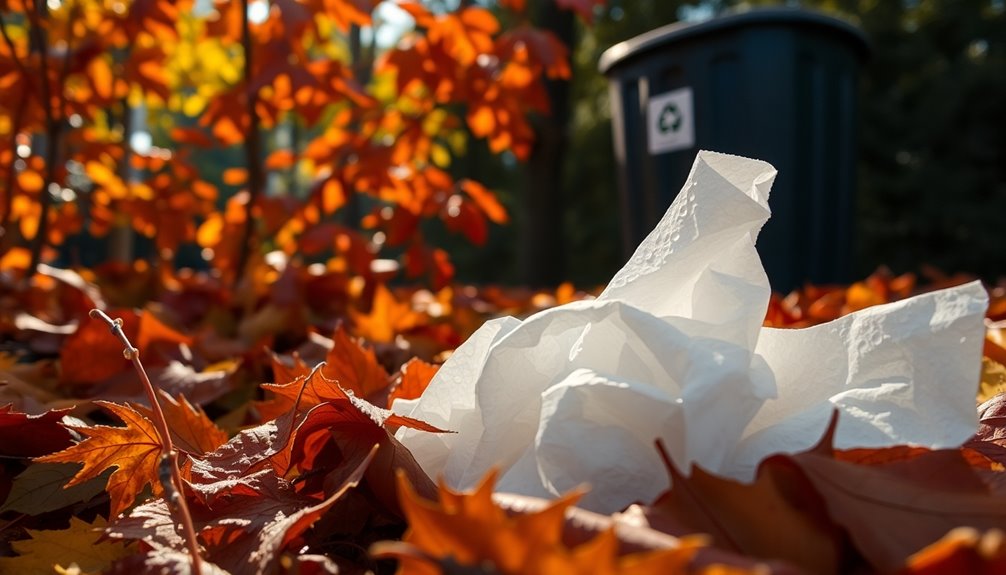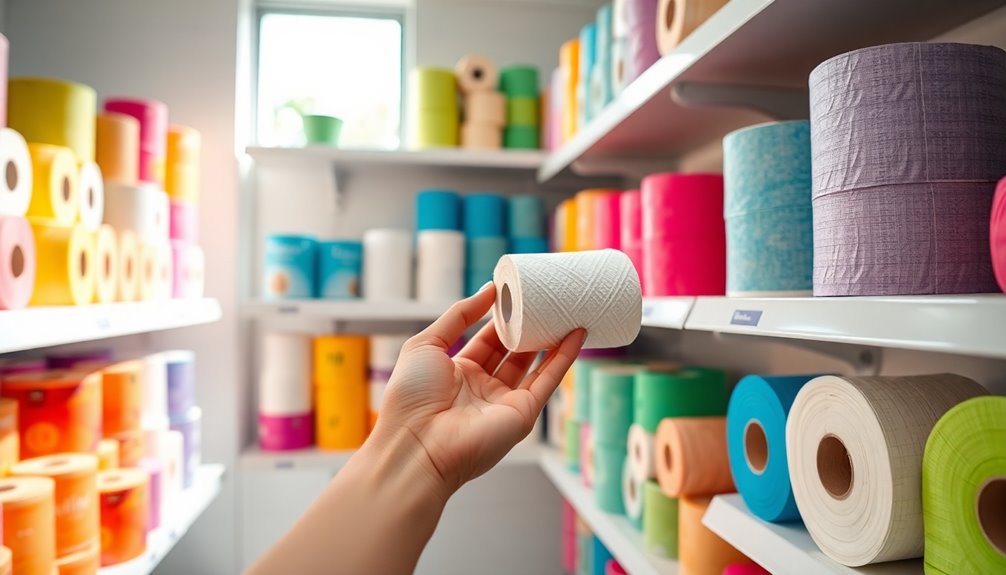Tissue paper isn't recyclable, and the truth might surprise you. Its short fiber structure and often contamination make it unsuitable for recycling. Instead, when you toss it in the trash, it contributes to landfill waste, generating harmful methane emissions. However, if the tissue paper's uncontaminated, composting is a better option for the environment. You can also get creative and use tissue paper for crafts, or as eco-friendly packing material. By choosing sustainable products, you can help reduce its environmental impact. Want to discover more about what you can do with tissue paper?
Key Takeaways
- Most tissue paper cannot be recycled due to its short fiber structure and contamination from use.
- Tissue paper often ends up in landfills, contributing to significant waste generation in the U.S.
- Composting uncontaminated tissue paper is a better alternative, reducing methane emissions compared to landfilling.
- Some tissue products contain recycled fibers, enhancing their eco-friendliness but still may not be recyclable.
- Certifications like FSC and PEFC promote responsible sourcing, but recycling tissue paper remains challenging.
Tissue Paper's Hidden Environmental Impact
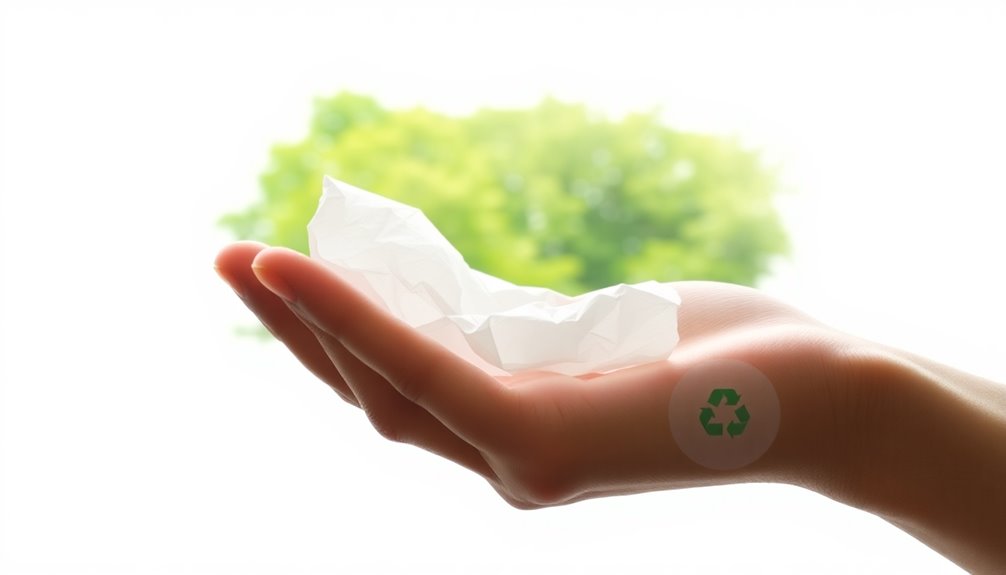
When you reach for a roll of tissue paper, you might not realize its hidden environmental impact. Despite being made from paper, most tissue paper cannot be recycled due to its short fiber structure and contamination from use. This means that over 4 million tons of tissue paper generated in the U.S. each year typically ends up in landfills, contributing significantly to waste.
However, there are sustainable alternatives. You can compost uncontaminated tissue, which enriches soil and reduces methane emissions compared to landfilling. This eco-friendly approach promotes better waste management practices and reflects the growing trend of circular economy practices that emphasize reuse and recycling. It's also essential to consider the sourcing of tissue paper. Around 90% of the wood used for paper products in the U.S. comes from sustainably managed forests, which helps reduce the overall environmental impact of the pulp and paper industry. Additionally, choosing products with energy efficiency ratings can further minimize your overall environmental footprint.
While tissue paper cannot be recycled like other paper products, opting for compostable or sustainable packaging options can make a difference. By being mindful of your tissue paper choices and exploring alternatives, you can contribute positively to the environment and promote a more sustainable future.
Tissue Paper Production Process
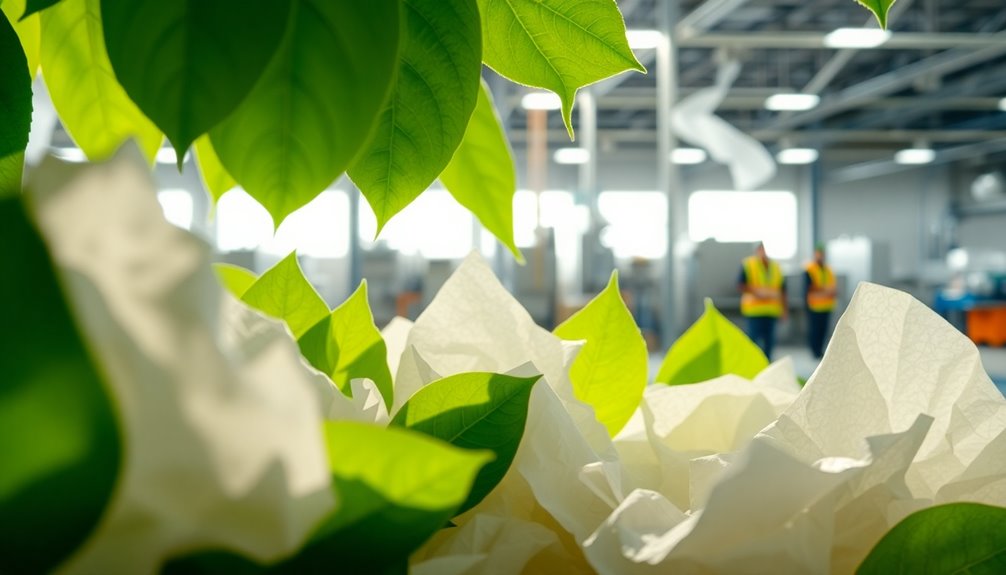
While you might think of tissue paper as a simple product, its production process is quite intricate. Tissue paper is made primarily from wood pulp, which undergoes extensive processing to achieve an extreme thinness. This pulp is often blended with recycled fibers, including newspapers, to enhance its eco-friendliness and provide environmental benefits. By utilizing recycled materials, manufacturers help reduce waste and promote sustainability.
During this production process, various additives are added to improve the paper's color, strength, and absorbency, resulting in a diverse range of products suitable for different packaging needs. However, it's important to note that making tissue paper typically requires significant energy and water. Efficient mills now strive to minimize water usage, aiming for as low as 17,000 liters per ton of paper produced.
Moreover, sustainable practices in tissue paper production are reinforced by international agreements, ensuring that most wood comes from sustainably managed forests. Thus, while the recyclability of tissue paper may be questioned, the production process incorporates methods that prioritize environmental responsibility and resource efficiency.
Use Tissue Paper for Crafts

Tissue paper is a versatile material that can breathe life into your craft projects. You can easily repurpose it for a variety of creative endeavors, from colorful decorations to handmade cards or even papier-mâché items. Its lightweight and thin nature makes it perfect for layering in gift wrapping or scrapbooking, adding both texture and visual interest to your creations.
Artists often use tissue paper for decoupage, adhering it to surfaces like furniture or canvas. This technique allows you to create unique designs and patterns that enhance your home decor. Shredded tissue paper also serves as an eco-friendly filler for gift baskets and packing materials, or you can use it to whip up vibrant confetti for celebrations.
Environmental Impact Assessments

Crafting with tissue paper not only showcases its versatility but also highlights the importance of understanding its environmental impact. Environmental impact assessments reveal that tissue paper production is energy-intensive, consuming energy levels comparable to steel production. This fact underscores the need for improved energy efficiency among paper manufacturers.
In the U.S., the industry generates over 4 million tons of waste annually, stressing the importance of sustainable disposal practices to minimize environmental harm. Efficient paper mills can significantly reduce water usage to as low as 17,000 liters per tonne of paper, demonstrating a potential pathway for resource conservation.
Moreover, the pulp and paper industry uses various chemicals, making comprehensive wastewater treatment essential before returning it to the environment to limit pollution. Certifications like FSC, PEFC, and EU Ecolabel play a crucial role in these assessments, ensuring that tissue paper is sourced responsibly and produced sustainably.
Corporate Sustainability Initiatives
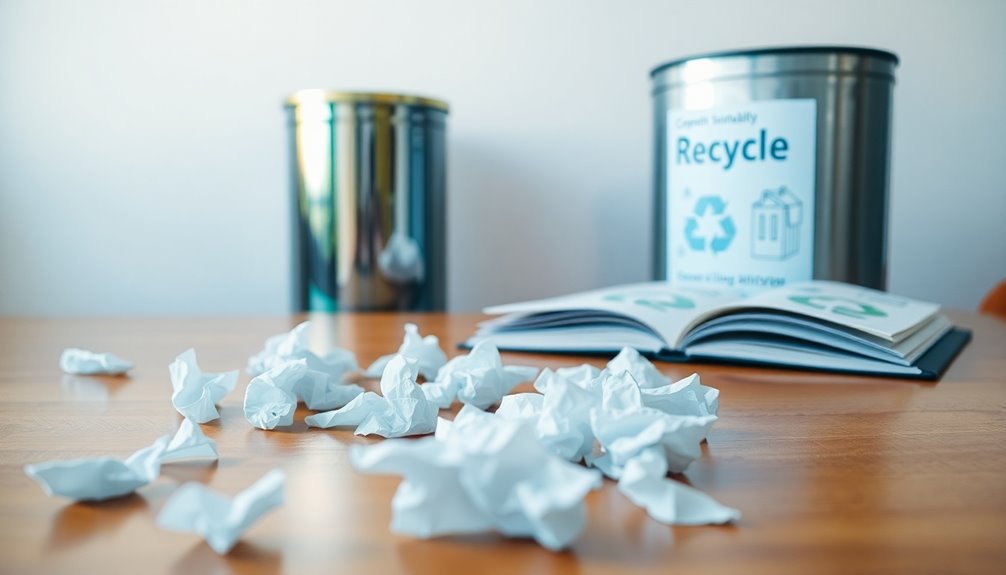
Corporate sustainability initiatives play a crucial role in addressing environmental challenges and promoting responsible practices within the tissue paper industry. Many companies are stepping up, focusing on recycling and waste reduction to align with the circular economy model. This approach minimizes landfill contributions and encourages the responsible use of resources.
Certifications like FSC and PEFC are vital for ensuring that the paper products you use are sourced sustainably. When you choose brands that hold recognized environmental accreditation, you support businesses committed to protecting forests and promoting sustainability. For instance, Rentokil Initial has pledged to achieve Net Zero by 2040, with an impressive 96% of its globally supplied paper meeting these high standards.
Moreover, transparency in supply chains is increasingly important. Companies are now providing you with detailed information about the origins and sustainability practices of their products. This enables you to make informed choices that contribute to a healthier environment. Additionally, some initiatives also address food waste, further enhancing their sustainability efforts. By engaging with these corporate sustainability initiatives, you're playing an active role in promoting responsible consumption and a more sustainable future.
Environmental Consequences of Tissue Paper
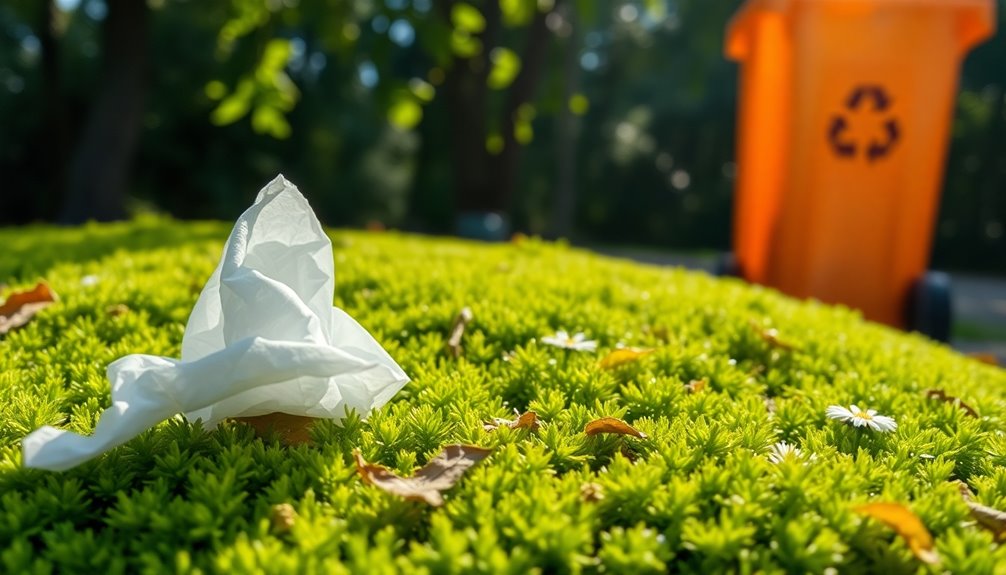
Every year, the production of tissue paper in the U.S. generates over 4 million tons, highlighting the pressing need for sustainable practices to lessen its environmental footprint. The environmental impact of tissue paper is significant, as creating it involves considerable energy consumption, similar to that of steel production. This energy use contributes to greenhouse gas emissions, which affect climate change.
While trees are renewable resources, unsustainable harvesting practices can lead to deforestation, habitat loss, and a decline in biodiversity. The pulp and paper industry also employs various chemicals during production, many of which can pollute air and waterways if not properly managed. Adequate wastewater treatment is essential to mitigate these effects.
On a positive note, you can take action by opting for recycling and composting. Recycling tissue paper can conserve resources, while composting it helps reduce methane emissions that occur when it's sent to landfills. Composting not only promotes a more eco-friendly disposal method but also enriches soil health and supports nutrient cycling. By being mindful of tissue paper production and disposal, you can help reduce its detrimental environmental consequences.
Frequently Asked Questions
Are Tissues Recyclable or Not?
You might think tissues are recyclable, but that's not the case for used ones. Their contamination from germs makes them unsuitable for recycling. While clean, unused tissues can often be recycled, most recycling centers won't accept used tissues due to health risks and weak fiber structure. If you want to dispose of tissues properly, throw them in the trash instead. Always check with your local recycling facility for specifics on clean tissue paper.
Can Kleenex Tissue Be Recycled?
You might think about recycling Kleenex tissues, but unfortunately, they're not suitable for that. Contaminated with oils and germs, used tissues can pose health risks during the recycling process. Plus, their short, weak fibers don't hold up well for recycling compared to other paper products. If your tissues are uncontaminated, composting is an option, but otherwise, it's best to toss them in the regular trash to keep things safe.
Why Is Tissue Paper Not Recyclable?
Tissue paper isn't recyclable mainly due to its low-quality fibers, which weaken its structure. When tissue gets contaminated with food or bodily fluids, recycling facilities can't process it because of hygiene concerns. Plus, recycling tissue paper often isn't cost-effective for facilities, which prefer easier materials to manage. Specialized equipment is usually necessary for its recycling, but most facilities lack this, making it difficult to recycle tissue paper effectively.
What Is the Truth About Paper Recycling?
The truth about paper recycling is that not all paper can be recycled effectively. While many types of paper, like newspapers and cardboard, are recyclable, others, like tissue paper, often aren't due to their short fibers and contamination. You might not realize that recycling facilities struggle with contaminated materials, which can pose health risks. Instead of tossing used tissue in the bin, consider composting uncontaminated paper to support sustainability efforts.

